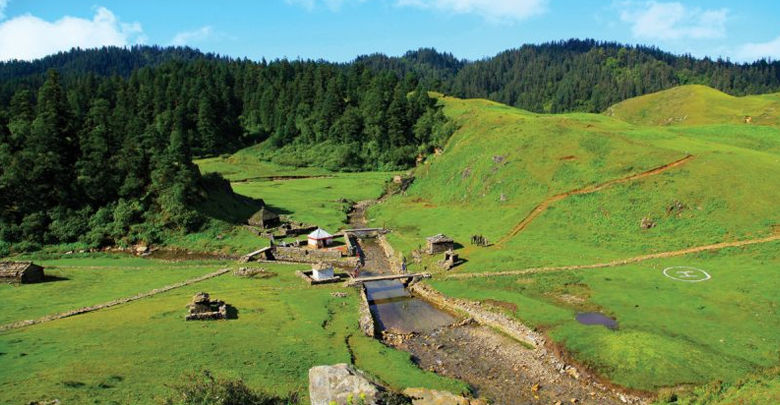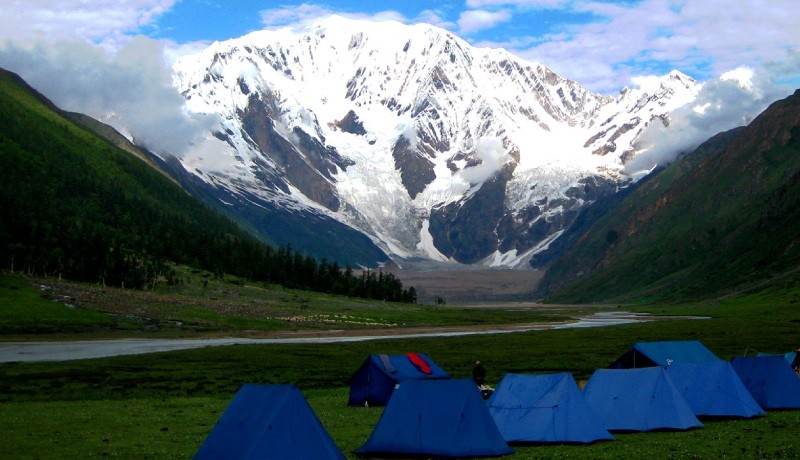Far West Nepal is the most remote, untouched and unexplored region of Nepal. In terms of development, the far west of Nepal comes at the bottom of almost every list, but for adventure and wonder, the region is near the top of the class. This is a landscape of deep, dank forests, sparkling sheets of water, lonely ice and snow-covered mountains, narrow canyons and ancient villages.
For a trekker, western Nepal offers many challenges and logistical problems. However, the payback is a wide range of untouched mountainous country waiting to be explored. You need patience and to be on a fully supported camping trek, but if you’re looking for something truly different, challenging and full of reward, then the far west of Nepal will probably be for you.
An Introduction to the Sudurpaschim Province:
Sudurpaschim Province is a province located in the far-western part of Nepal that was formed in 2015 after the adoption of the new constitution. The province is bordered by India to the south and the west, Karnali Province to the east, and the Tibet Autonomous Region of China to the north. Sudurpaschim Province is divided into nine districts, namely Kanchanpur, Dadeldhura, Baitadi, Darchula, Bajhang, Bajura, Achham, Doti, and Kailali.
The province has a rich cultural heritage and is known for its natural beauty, with the Himalayas forming a backdrop to much of the region. The region is home to several protected areas, including the Shuklaphanta National Park and the Api Nampa Conservation Area. Sudurpaschim Province is also home to several pilgrimage sites and is an important destination for religious tourism in Nepal. Some of the popular pilgrimage sites in the region include the Baitadi Khodpe and Kedar temples, the Badimalika temple in Bajura, Khaptad area, the Dadeldhura Durga Bhawani temple, and the Malika Arjun temple in Bajhang. From the largest herd of Deer in Suklaphanta National Park to the high Alpine landscape of Api and Saipal Himal, you will have an amazing exploration of wildlife and nature in the far west.

The 4 major trekking destinations of the Far West:
In this blog, we will give you an introduction of the four major treks that you can add to your next adventure list and provide you with a detailed itinerary for the same. The four treks are as follows:
- Api Base Camp Trek
- Khaptad National Park Trek
- Badimalika Trek
- Saipal Base Camp Trek
1. Api Base Camp Trek
The Api Base Camp Trek is a challenging and off-the-beaten-path trekking experience that takes place in the Far Western Region of Nepal. This trek is named after Api Mountain, which is the highest peak in the region, standing tall at 7,132 meters (23,389 ft). The trek takes you through the stunning and remote landscapes of the Api Nampa Conservation Area, providing a rare opportunity to experience the local culture, tradition, and lifestyle of the region. One of the main highlights of the Api Base Camp Trek is the stunning views of the surrounding peaks, including Api, Nampa, and Saipal. The trail provides several vantage points from where you can witness the majestic snow-capped mountains in all their glory.
The Api Base Camp Trek is a relatively new trekking route in Nepal and has gained popularity in recent years among adventure enthusiasts who seek to explore remote and less-visited parts of the country. The trek is considered a challenging and strenuous trek, requiring a good level of fitness and stamina to complete. The trail takes you through a diverse range of landscapes, including lush forests, alpine meadows, and rocky terrain. Along the way, you will come across several traditional villages inhabited by the indigenous communities of the region, including the Bote, Dura, and Byanshi people.

Itinerary for Api Base Camp Trek:
Day 1: Night bus ride from Kathmandu to Attariya, Dhangadhi
Day 2: Drive to Ganna, Darchula
Day 3: Drive and Trek to Ghusa
Day 4: Trek to Dhauli Odar
Day 5: Trek to Api Base Camp and Back
Day 6: Return trek to Khaikot
Day 7: Return trek to Ghusa
Day 8: Return trek and Drive to Ganna
Day 9: Return drive to Attariya, Dhangadhi and night bus to Kathmandu
2. Khaptad National Park Trek:
Khaptad National Park Trek offers one of the non-touristic wilderness national park experiences in Nepal that is rarely visited by many tourists. The area of the national park is 225 square km. The Khaptad National Park, one of the main attractions of Khaptad, was established in 1984 in the far western region of Nepal. It is covered by beautiful oak and rhododendron forests.
Khaptad area is known as the ground-heaven of far west Nepal. Known for its natural beauty and biological diversity, Khaptad area can be reached through Doti, Achham, Bajang and Bajura District of Nepal. It is easier to reach Khaptad area through Bajhang and Doti District. In addition; its natural varieties, the Khaptad National Park is a very renowned religious place as it is the domicile of Hindu guru “Khaptad Swami” or “Khaptad Baba”, a renounced hermit. Khaptad Baba lived here for many years and found many healing herbal plants.
One of the major attractions for tourists in this trek is the Khaptad Lake and the wonderful view of Api and Saipal Himal range. The biggest carnival known as Ganga Dashahara Carnival gets held in Khaptad on 14 Jestha of Nepali month that falls in the last week of May. For the tourists, the carnival is a great opportunity to see far western culture and lifestyle. Butchering, alcohol and tobacco are forbidden in his area.

Itinerary for Khaptad National Park Trek
Day 1: Night bus ride from Kathmandu to Attariya, Dhangadhi
Day 2: Bus ride from Attariya to Jhigrana via Dipayal
Day 3: Trek from Jhigrana to Khaptad (3,000m)
Day 4: Explore Khaptad
Day 5: Explore Khaptad (Optional)
Day 6: Return Trek from Khaptad to Jhigrana
Day 7 & 8: Bus ride from Jhigrana to Attariya and night bus to Kathmandu
3. Badimalika Trek:
The Badimalika Trek is another trekking destination in the far-western region of Nepal that is slowly gaining popularity. Located in Bajura district, this trek takes you to the Badimalika Temple, which is situated at an altitude of 4,200 meters and is dedicated to the Hindu goddess Bhagwati.
The trek starts from the village of Jadga and the trail offers stunning views of the Saipal Himalayan range. Along the way, you will also get to witness the unique culture and lifestyles of the local communities, who are mainly from the Brahmin and Chhetri castes. Bajura is one of the lesser-known regions of Nepal that conveys normal, strict, and recorded significance.
The major highlight of this trek would be the broad green meadows brimming with cattles and various types of blossoms that will, for sure, cause anybody to overlook the hardships of the journey. Different ethnic gatherings living here praise celebrations like Fagu, Deval Jatra, Sain Kande Jatra.
Badimalika Temple is one of the significant shrines in Nepal. To reach Badimalika sanctuary, one needs to embark through a troublesome trekking journey. The sanctuary is in a distant area and since the course to the sanctuary isn’t very much evolved, there is an absence of hotels and eateries for the explorers to rest and eat.

Itinerary for Badimalika Trek:
Day 1: Night bus ride from Kathmandu to Attariya, Dhangadhi
Day 2: Drive by jeep to Jadga. Overnight in Tent Camp
Day 3: Trek from Jadga to Karala
Day 4: Trek from Jadga to Tribeni Badimalika
Day 5: Trek from Tribeni Badimalika to Nateshwori
Day 6: Trek from Nateshwori to Dhangadhi via Mourya
Day 7: Return Bus ride from Dhangadhi to Kathmandu
4. Saipal Base Camp Trek
The Saipal Himal Trek is another beautiful but challenging trek in the far western region of Nepal and the last one in our list. The trek starts in Sanfebagar and takes you through lush forests, rocky terrain, and alpine meadows, with stunning views of mountains and valleys. You’ll cross high passes, including the Nagma La and Khyala Lagna passes, which offer breathtaking views. You’ll also have the opportunity to experience the unique culture and hospitality of the people who live in this remote region.
The Saipal peak, western Nepal’s second highest mountain, is the main attraction of this trek. The trek leads through pristine conifer forests to the base camp for Saipal, which is located at an altitude of 7,031m. It’s important to note that there are no facilities for trekkers along the way, so it’s recommended to bring everything you might need from Kathmandu. Additionally, don’t expect to find local porters easily; you’ll have to make prior arrangements.
The Saipal Himal Trek is less traveled compared to other treks in Nepal, so you’ll likely encounter fewer trekkers and have a more authentic experience. It’s a great choice for adventurous trekkers who are looking for a challenge and want to explore a remote and beautiful part of Nepal.

Itinerary for Saipal Base Camp Trek:
Day 1: Night bus ride from Kathmandu to Attariya, Dhangadhi
Day 2: Drive from Dhangadi to Chainpur
Day 3: Drive from Chainpur to Panalta via Rupatola and trek to Kuwa
Day 4: Trek from Kuwa to Dhalaun
Day 5: Trek from Dhalaun to Jima
Day 6: Trek from Jima to Dodale
Day 7: Trek from Dodale to Aulagaad
Day 8: Trek from Aulagaad to Saipal Base Camp and Back to Dodale
Day 9: Return trek from Dodale to Kuwa
Day 10: Trek to Panalta and drive back to Chainpur
Day 11: Drive from Chainpur to Dhangadhi
Day 12: Drive from Dhangadhi to Kathmandu
This wraps up our introduction to trekking in the far western region of Nepal. We hope that these treks will gain more popularity in the future so that more and more travelers and adventure seekers get to witness the majestic beauty this place has to offer. It is also extremely important that the local, provincial and the central government bodies of Nepal prioritize development of the far west Nepal. This will not only make it easier for travelers to visit these places but open new opportunities to the people living in these areas.


